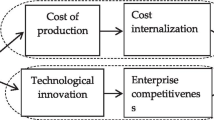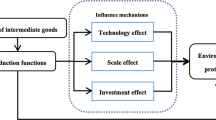Abstract
The pollution emissions trading system (PETS) pilot policy is China’s first large-scale implementation of market-based environmental regulations; whether it can reduce pollution emissions and improve the export competitiveness is crucial for China to achieve the coordinated development of environment and economy. Based on the panel data of Chinese listed companies from 2003 to 2016, this paper considers the PETS pilot policy as a natural experiment, and investigates the impact of the policy on export products’ quality using the difference-in-difference (DID) model. We found that (1) the PETS pilot policy has significantly improved the quality of listed companies’ export products. (2) Technological innovation plays a partial intermediary role in promoting export products’ quality by the PETS pilot policy; the “Porter Hypothesis” has been verified in China. (3) When the listed companies with different characteristics face the PETS pilot policy, the quality of their export products will show a differentiated development trend. Based on the above research conclusions, we put forward corresponding recommendations for China to realize the coordinated development of environment and trade.



Similar content being viewed by others
Data availability
The datasets used and/or analyzed during the current study are available from the corresponding author on reasonable request.
References
Atkin A, Khandelwal AK, Osman A (2017) Exporting and firm performance: evidence from a randomized experiment. Quart J Econ 132(2):551–615
Barbera AJ, McConnell VD (1990) The impact of environmental regulations on industry productivity: direct and indirect effects. J Environ Econ Manag 18(1):50–65
Barbieri N, Ghisetti C, Gilli M, Marin G, Nicolli F (2016) A survey of the literature on environmental innovation based on main path analysis. J Econ Surv 30(3):596–623
Baron RM, Kenny DA (1986) The moderator-mediator variable distinction in social psychological research: conceptual, strategic, and statistical considerations. J Pers Soc Psychol 51(6):1173–1182
Bas M, Strauss-Kahn V (2015) Input-trade liberalization, export prices and quality upgrading. J Int Econ 95(2):250–262
Becker SO, Egger PH (2013) Endogenous product versus process innovation and a firm’s propensity to export. Empir Econ 44(1):329–354
Bellone F, Musso P, Nesta L, Schiavo S (2010) Financial constraints and firm export behaviour. World Econ 33(3):347–373
Brambilla I, Porto G (2016) High-income export destinations, quality and wages. J Int Econ 98:21–35
Bu ML, Qiao ZZ, Liu BB (2020) Voluntary environmental regulation and firm innovation in China. Econ Model 89:10–18
Cai XQ, Lu Y, Wu MQ, Yu LH (2016) Does environmental regulation drive away inbound foreign direct investment? Evidence from a quasi-natural experiment in China. J Dev Econ 123:73–85
Chen MW, Lu CC, Tian Y (2021) Export price and quality adjustment: the role of financial stress and exchange rate. Econ Model 96:336–345
Chen N, Juvenal L (2016) Quality, trade, and exchange rate pass-through. J Int Econ 100:61–80
Chen YL, Li Y, Zhang J (2016) The bank-firm relationship: helping or grabbing. Int Rev Econ Finance 42:385–403
Cheng ZH, Li LS, Liu J (2017) The emissions reduction effect and technical progress effect of environmental regulation policy tools. J Clean Prod 149:191–205
Costantini V, Crespi F (2008) Environmental regulation and the export dynamics of energy technologies. Ecol Econ 66(2–3):447–460
Costantini V, Mazzanti M (2012) On the green and innovative side of trade competitiveness? The impact of environmental policies and innovation on EU exports. Res Policy 41(1):132–153
Cull R, Xu LC (2005) Institutions, ownership, and finance: the determinants of profit reinvestment among Chinese firms. J Financ Econ 77(1):117–146
Du,W.J., Li,M.J., 2020.Influence of environmental regulation on promoting the low-carbon transformation of China’s foreign trade: based on the dual margin of export enterprise. J Clean Prod 244.
Elrod A, Mali AS (2017) The effect of environmental regulation on plant-level product mix: a study of epa’s cluster rule. J Environ Econ Manag 83(C):164–184
Fan HC, Li Y, Yeaple SR (2015a) Credit constraints, quality, and export prices: theory and evidence from China. J Comp Econ 43(2):390–416
Fan HC, Li Y, Yeaple SR (2015b) Credit constraints, quality, and export prices:theory and evidence from China. J Comp Econ 43(2):390–416
Feng C, Shi B, Kang R (2017) Does Environmental policy reduce enterprise innovation?—evidence from China. Sustainability 9:872
Fieler AC, Eslava M, Xu DY (2018) Trade, quality upgrading, and input linkage: theory and evidence from columbia. Am Econ Rev 108(1):109–146
Ghani GM (2012) Does trade liberalization effect energy consumption? Energy Policy 43:285–290
Goksel T (2012) Financial constraints and international trade patterns. Econ Model 29(6):2222–2225
Hallak JC, Schott PK (2011) Estimating cross-country differences in product quality. Q J Econ 126(1):417–474
Hering L, Poncet S (2014) Environmental policy and exports: evidence from Chinese cities. J Environ Econ Manag 68(2):296–318
Hu C, Lin F, Tan Y, Tang Y (2019) How exporting firms respond to technical barriers to trade? World Econ 42:1400–1426
Hu W, David P, Tan Y (2021) Exchange rate induced export quality upgrading: a firm-level perspective. Econ Model 2021:336–348
Hummels D, Klenow PJ (2005) The variety and quality of a nation’s exports. Am Econ Rev 95(3):704–723
Hwang JA, Kim Y (2017) Effects of environmental regulations on trade flow in manufacturing sectors: comparison of static and dynamic effects of environmental regulations. Bus Strategy Environ 26(5):688–706
Johnstone N, Managi S, Rodríguez MC, Haščič I, Fujii H, Souchier M (2017) Environmental policy design, innovation and efficiency gains in electricity generation. Energy Econ 63:106–115
Judd CM, Kenny DA (1981) Process analysis: estimating mediation in treatment evaluations. Eval Rev 5(5):602–619
Khandelwal A, Schott PK, Wei SJ (2013) Trade Liberalization and Embedded Institutional Reform: evidence from Chinese exporters. Soc Sci Electronic Publish 103(6):2169–2195
Khandelwal AK (2010) The long and short quality ladders. Rev Econ Stud 77(4):1450–1476
Lee,J., Veloso,F.M., Hounshell, D.A., 2011. Linking induced technological change, and environmental regulation: evidence from patenting in the U.S. auto industry. Res Policy 1240–1252.
Levinson A, Taylor MS (2008) Unmasking the pollution haven effect. Int Econ Rev 49(1):223–254
Liu M, Shadbegian R, Zhang B (2017) Does environmental regulation affect labor demand in China? Evidence from the textile printing and dyeing industry. J Environ Econ Manag 86:277–294
Liu,Q., Ma H., 2020.Trade policy uncertainty and innovation: firm level evidence from China’s WTO accession. J Int Econ 127
Manova K, Zhang Z (2012) Export prices across firms and destinations. Q J Econ 27(1):379–436
Marconi D (2012) Environmental regulation and revealed comparative advantages in europe: is China a pollution haven? Rev Int Econ 3:616–635
Martín-Tapia I, Aragón-Correa JA, Rueda-Manzanares A (2010) Environmental strategy and exports in medium, small and micro-enterprises. J World Bus 45(3):266–475
Nesta L, Vona F, Nicolli F (2014) Environmental policies, competition and innovation in renewable energy. J Environ Econ Manag 67(3):396–411
Pei J, Sturm B, Yu A (2021) Are exporters more environmentally friendly? A re-appraisal that uses China’s micro-data. World Economy 44:1402–1427
Peng HR, Qi SZ, Cui JB (2021) The environmental and economic effects of the carbon emissions trading scheme in China: the role of alternative allowance allocation. Sustain Prod Consum 28:105–115
Porter ME, van der Linde C (1995) Toward a new conception of the environment - competitiveness relationship. J Econ Perspect 9(4):97–118
Qi SZ, Cheng SH, Cui JB, 2021. Environmental and economic effects of China’s carbon market pilots: empirical evidence based on a DID model. J Clean Prod 279
Rubashkina Y, Galeotti M, Verdolini E (2015) Environmental regulation and competitiveness:empirical evidence on the porter hypothesis from european manufacturing sectors. Energy Policy 83(3):288–300
Shao S, Yang ZB, Yang LL, Ma S (2019) Can China’s energy intensity constraint policy promote total factor energy efficiency? Evidence from the industrial sector. Energy J 40:101–128
Shi X, Xu Z (2018) Environmental regulation and firm exports: evidence from the eleventh Five-Year Plan in China. J Environ Econ Manag 89:187–200
Smallwood AD (2019) Analyzing exchange rate uncertainty and bilateral exporter growth in China: a multivariate GARCH-based approach. Econ Model 82:332–344
Stavropoulos S, Wall R, Xu YZ (2018) Environmental regulations and industrial competitiveness: evidence from China. Appl Econ 50(12):1378–1394
Tang HL, Liu JM, Mao J, Wu JG (2020) The effects of emission trading system on corporate innovation and productivity-empirical evidence from China’s SO2 emission trading system. Environ Sci Pollut Res 27:21604–21620
Walter I (1974) International trade and resource diversion: the case of environmental management. Weltwirtschaftliches Archiv 110:482–493
Wang ZH, Zhang B, Zeng HL (2016) The effect of environmental regulation on external trade: empirical evidences from Chinese economy. J Clean Prod 114:55–61
Weber CL, Peters GP (2009) Climate change policy and international trade: policy considerations in the US. Energy Policy 37(2):432–440
Zhang,Y., Cui,J.B., Lu,C.H., 2020.Does environmental regulation affect firm exports? Evidence from wastewater discharge standard in China. China Econ Rev 61
Funding
This work received financial support from the Major Program of National Social Science Foundation of China (no. 18ZDA107), the National Key R&D Program of China (no. 2018YFC1509005), and the Pilot Programs for Major Science, Technology, and Innovation Projects toward 2030 of China Energy Investment Corporation (no. GJNY2030XDXM-19–20.1).
Author information
Authors and Affiliations
Contributions
Shaozhou Qi: conceptualization, writing—review and editing.
Shihan Cheng: data curation, methodology, formal analysis, writing—original draft.
Corresponding author
Ethics declarations
Ethics approval and consent to participate
Not applicable.
Consent for publication
Not applicable.
Competing interests
The authors declare no competing interests.
Additional information
Responsible Editor: Ilhan Ozturk.
Publisher's Note
Springer Nature remains neutral with regard to jurisdictional claims in published maps and institutional affiliations.
Rights and permissions
About this article
Cite this article
Qi, S., Cheng, S. The influence of China’s pollution emissions trading system on the listed companies’ export products’ quality. Environ Sci Pollut Res 29, 20145–20159 (2022). https://doi.org/10.1007/s11356-021-17228-5
Received:
Accepted:
Published:
Issue Date:
DOI: https://doi.org/10.1007/s11356-021-17228-5




